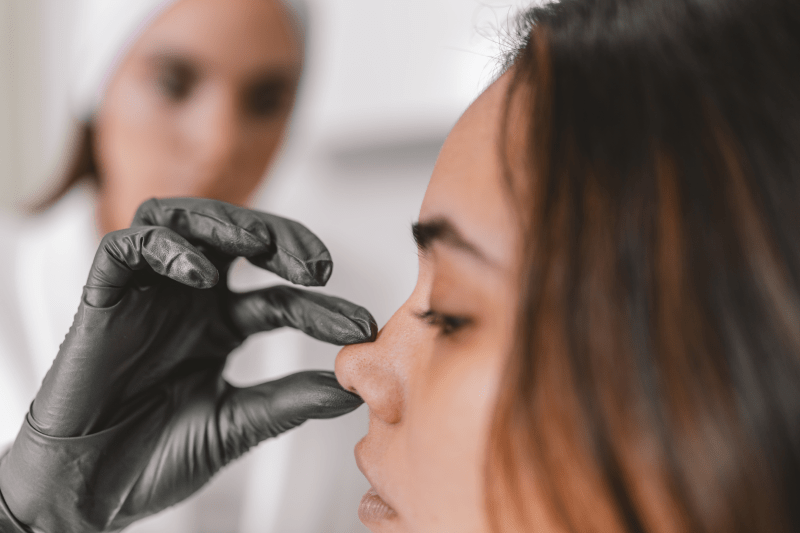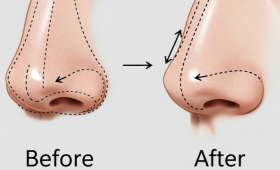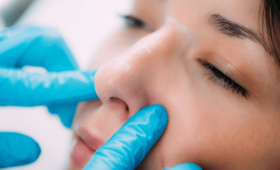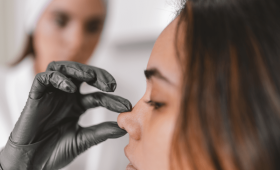What Is Rhinoplasty Surgery?
Rhinoplasty surgery, also known as a nose job, is a surgical procedure aimed at changing the shape and size of the nose. This operation is performed to correct the nasal bridge, lift the nasal tip, reduce the size of the nostrils, or improve the proportion between the nose and the face. Rhinoplasty can be performed to address both aesthetic concerns and to correct breathing problems. The surgeon conducts a detailed analysis to create the most suitable nose shape for the patient’s facial features and aesthetic expectations. The surgery gives the person’s face a more harmonious and natural appearance.
Who Is a Suitable Candidate for Rhinoplasty?
Suitable candidates for rhinoplasty surgery are generally individuals aged 18 and over who have completed their nasal development. It is important that candidates are in good general health, have realistic expectations from the surgery, and have the physical capacity to handle the risks of the operation. People who are bothered by the shape of their nose, who have breathing problems due to a deviated septum, or who are not satisfied with a previous surgery are suitable candidates. The surgeon evaluates each candidate individually to make the right decision.
What Is the Average Cost of a Nose Job in Turkey?
The cost of rhinoplasty surgery in Turkey is quite economical compared to Western countries. Prices vary depending on the surgeon’s experience, the hospital where the surgery will be performed, the technique used, and the scope of the operation (such as primary rhinoplasty, revision, or functional correction). Generally, prices are offered in packages that include the surgery, anesthesia, hospital stay, medications, and post-operative care. These packages make all costs transparent for foreign patients, preventing unexpected additional costs.
Why Is Turkey Preferred for Rhinoplasty?
Turkey has a worldwide reputation for rhinoplasty surgeries. The main reasons for this include the presence of expert and experienced surgeons, clinics and hospitals equipped with modern technology, high success rates, and affordable costs. Health tourism policies and government support have led to significant growth in this field. Furthermore, the country’s cultural and historical richness makes the treatment process a holiday experience, which is attractive for patients.
How Long Does the Rhinoplasty Procedure Take?
The duration of rhinoplasty surgery varies depending on the technique applied and the scope of the operation. On average, a primary rhinoplasty surgery takes between 2 to 4 hours. Simpler operations (like a tip rhinoplasty) can take less time, while revision surgeries or comprehensive corrections may take longer. All necessary precautions are taken for the patient’s comfort and safety during the surgery. In long-lasting operations, surgeons and their teams take regular breaks to ensure the operation is completed in the best possible way.
What Is the Post-operative Recovery Process Like?
The post-operative recovery process after rhinoplasty varies from person to person, but generally, swelling and bruising are seen during the first few days after the surgery. The splint and tapes on the nose are removed after a week. During this period, some of the swelling subsides. The majority of patients can return to their normal social lives within 10-14 days. It can take between 6 months to 1 year for the post-operative swelling to completely subside and for the nose’s shape to fully settle. It is very important to follow the doctor’s recommendations during this process.
Are the Results of Rhinoplasty Permanent?
The results of rhinoplasty surgery, when performed by an experienced surgeon using the right technique, are generally permanent. The new nose shape obtained with the surgery maintains its permanence for a lifetime. However, as the aging process continues, the nasal tissue, like other facial tissues, can change over time. This situation does not affect the success of the surgery, it is simply a natural change in the nasal structure with age.
What Are the Possible Risks of the Surgery?
As with any surgical procedure, rhinoplasty surgery also has some risks and complications. Possible complications include bleeding, infection, reactions to anesthesia, nasal congestion, numbness at the tip of the nose, and aesthetically undesirable results. These risks are minimized when the surgery is performed by an experienced surgeon using the right techniques. It is important to have a detailed discussion with your doctor about the possible risks before the surgery.
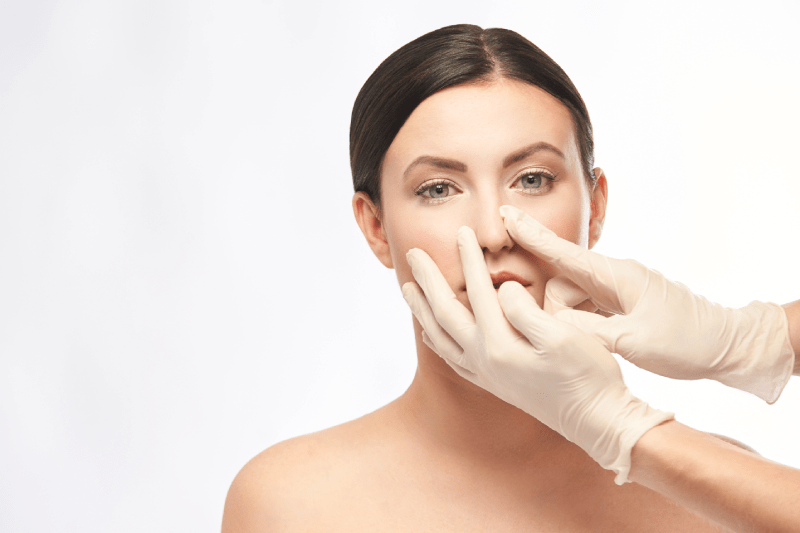
Do Scars Remain After the Surgery?
Rhinoplasty surgery is usually performed with a closed technique through the nostrils, and in this case, no externally visible scar remains. In surgeries performed with the open technique, a small incision is made in the area called the columella between the nostrils. This incision scar fades over time and becomes almost invisible. Paying attention to the healing process and following the surgeon’s recommendations helps to reduce the prominence of the scars.
What Type of Anesthesia Is Used?
Rhinoplasty surgery is generally performed under general anesthesia. This is a method where the patient is completely asleep during the surgery and does not feel any pain. General anesthesia allows the surgeon to perform the operation more comfortably and safely. Considering the duration and scope of the surgery, general anesthesia is the most suitable type for the patient’s comfort. In some cases, local anesthesia with sedation may also be preferred.
What Should Be Considered Before the Surgery?
It is vital to follow all the instructions given by your surgeon before the surgery. The use of blood-thinning medications and herbal supplements should be stopped at least two weeks beforehand. Smoking and alcohol consumption should be stopped at least one month in advance because these substances negatively affect the healing process. It is recommended not to wear makeup and to wear comfortable clothes on the day of the surgery. All these precautions help ensure the surgery is successful and safe.
Is There Pain After the Surgery?
The pain felt after rhinoplasty surgery is generally mild and can be easily controlled with pain relievers given to the patient after the surgery. The pain is felt most during the first few days. Applying a cold compress to reduce swelling and bruising also helps to alleviate the pain. The splints placed inside the nose after the surgery can create a slight feeling of pressure, but these are usually removed within a few days.
When Can I Return to Work?
The recovery process after rhinoplasty surgery depends on the patient’s job and the scope of the surgery. Patients can generally return to their office jobs or jobs that do not require heavy physical activity within a week. The significant reduction in swelling and bruising on the face determines this period. Those who have more strenuous jobs are advised to rest for a few more weeks until the recovery process is complete.
What Is the Ideal Age Range for Rhinoplasty?
The ideal age range for rhinoplasty surgery is the period when nasal development is complete. This is usually 17 for girls and 18 and older for boys. Surgeries performed at a young age can negatively affect nasal development. Although there is no age limit, the results of the surgery in older people may be different from those in younger people due to a decrease in skin elasticity.
What Techniques Are Used in Nose Surgery?
There are two main techniques commonly used in rhinoplasty surgery: open rhinoplasty and closed rhinoplasty. In the open rhinoplasty technique, a small incision is made between the nostrils, and the nasal skin is lifted to directly access the cartilage and bone structure. This technique is preferred in complex cases and revision surgeries. In the closed rhinoplasty technique, incisions are made inside the nostrils, and no externally visible scar remains. This technique is a less invasive method.
How Experienced Are the Surgeons in Turkey?
Since Turkey is one of the leading countries in the world in health tourism, its aesthetic surgeons are very experienced. Surgeons who perform thousands of operations a year have gained extensive experience with different nasal structures and aesthetic expectations. This experience allows for higher success rates and more natural results to be obtained. Additionally, many surgeons continuously improve themselves by participating in international training.
What Is the Pre-operative Consultation Process Like?
Aesthetic surgery clinics in Turkey generally offer an online consultation process for foreign patients. Patients send photos of their noses from different angles and their medical history to the surgeon via email or video conference. The surgeon evaluates this information to determine if the patient is suitable for the surgery and creates a preliminary treatment plan. When the patient arrives in Turkey, a detailed face-to-face examination is performed, and the final details of the surgery are clarified.
How Long Do I Need to Stay in Turkey for Rhinoplasty?
For foreign patients, the rhinoplasty surgery process usually takes 7 to 10 days. On the first day, patients arrive and settle in the clinic. The surgery is performed on the second day, and generally, a one-night hospital stay may be required. Staying in Turkey for a few more days is beneficial for the first stages of recovery and the first check-ups. The removal of the splint and stitches is also completed during this process.
What Is Tip Rhinoplasty?
Tip rhinoplasty (tipplasty) is a surgery where only the shape of the nasal tip is corrected, without making any changes to the nasal bridge or dorsum. It is performed to address problems such as a drooping tip, a wide tip, or asymmetry. This surgery is a less invasive method and has a shorter recovery process. The surgery can also often be performed under local anesthesia.
What Is Revision Rhinoplasty?
Revision rhinoplasty is a corrective operation applied to patients who have had one or more previous rhinoplasty surgeries. This surgery is performed for patients who are not satisfied with the results of their first operation or who have breathing problems. Revision surgeries can be more complex than primary surgeries and require more experience and expertise from the surgeon.
Can Aesthetic and Functional Nose Surgery Be Combined?
Yes, aesthetic and functional nose surgeries can often be combined in a single operation. Functional nose surgery corrects anatomical problems inside the nose that make breathing difficult (such as a deviated septum or enlarged turbinates). Aesthetic surgery, on the other hand, improves the external appearance of the nose. Solving both problems at the same time provides great benefits to the patient in terms of both aesthetics and health.
What Is Non-Surgical Nose Filling?
Non-surgical nose filling is a method where filler materials (usually hyaluronic acid) are used to temporarily correct the shape of the nose. This method is used to hide minor bumps on the nasal bridge, lift the nasal tip, or correct nasal asymmetry. Non-surgical nose filling is an ideal option for people who do not want to undergo surgery or who want to see the result of the surgery in advance. However, the results are temporary and need to be repeated.
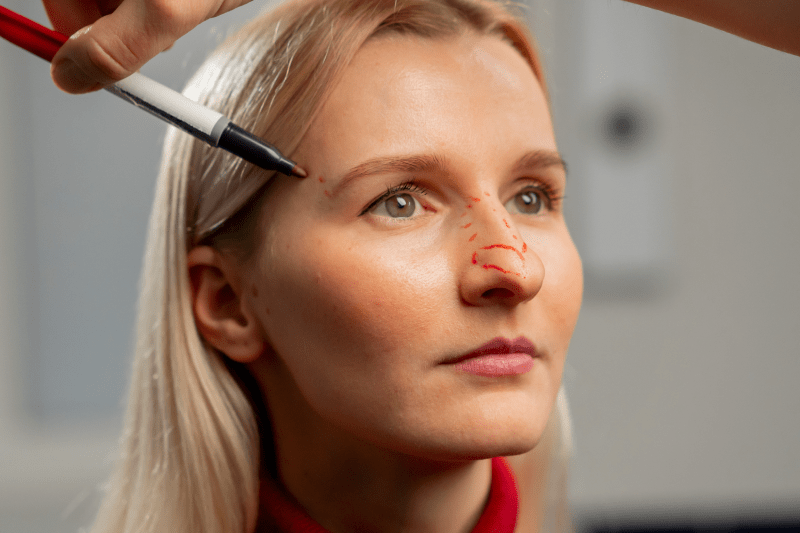
When Does the Swelling Go Down After the Surgery?
Swelling after rhinoplasty surgery reaches its peak within the first 24-48 hours. After that, the swelling slowly begins to go down. A significant reduction takes a week. 70-80% of the post-operative swelling goes down within the first month. It can take between 6 months to 1 year for the nose’s shape to fully settle and for the swelling to completely subside. It is important to be patient during this process and follow the doctor’s recommendations.
What Should Nutrition Be Like After the Surgery?
It is recommended that patients eat soft and warm foods for the first few days after the surgery. Pureed foods and soups that do not require chewing should be preferred. It is important to avoid hot and spicy foods. As the healing process progresses, one can gradually return to a normal diet. This way, the tension and sensitivity in the surgical area can be reduced.
How Is Glasses Use Affected After the Surgery?
After rhinoplasty surgery, glasses that put weight on the nose should not be used for a while. Glasses can put pressure on the newly shaped nasal bone and cause the shape to be distorted. Surgeons generally recommend not using glasses for at least 6 weeks after the surgery. During this period, patients can use contact lenses or a special glasses support.
Are There Language Services for Foreign Patients?
Yes, many aesthetic surgery clinics in Turkey have international patient departments specifically designed for foreign patients. These departments employ translators and patient coordinators who provide services in languages such as English, German, Arabic, and others to solve patients’ communication problems. This service ensures that patients feel safe and comfortable throughout their treatment process.
Why Are Before and After Photos Important?
Before and after photos are very important for both the patient and the surgeon. These photos allow for a detailed analysis of the patient’s nasal structure during the planning phase of the surgery. After the surgery, they help to objectively evaluate the results obtained. This way, patients can clearly see the changes before and after the surgery.
How Is a Nose That Is Harmonious with Facial Features Designed?
Designing a nose that is harmonious with facial features is one of the most important goals of rhinoplasty surgery. The surgeon makes a plan by taking into account the patient’s face shape, jawline, forehead, and eye structure. Computer-aided simulation programs allow the patient to see what their new nose will look like on their face in advance. This way, both the surgeon and the patient can reach a consensus on the results of the operation.
Is Fat Injection Used in Rhinoplasty?
In rhinoplasty surgeries, fat injection can be used to fill in slight depressions on the nasal dorsum or tip and to achieve a smoother appearance. This can be applied as an addition to nose surgery or as a standalone procedure. Fat taken from the patient’s own body is injected into the nasal area to provide fullness. Fat injection gives the nose a more natural volume.
How Is Post-operative Nose Care Done?
Post-operative nose care is very important for the success of the healing process. The surgeon may prescribe saline sprays or special solutions to clean the inside of the nose after the surgery. For the first few weeks, the nose should be protected from blows and one should avoid blowing their nose. Massaging the nose after the splint and tapes are removed can also help to reduce swelling.
What Can Be Done to Reduce Bruising After the Surgery?
To reduce post-operative bruising, applying a cold compress around the eyes for the first 48 hours is an effective method. Additionally, sleeping with the head elevated for the first few days also helps to reduce swelling and bruising. Regularly using the medications recommended by the surgeon and drinking plenty of fluids also support the healing process.
What Is Included in the Price of Nose Surgery?
Rhinoplasty prices in Turkey are generally offered in all-inclusive packages. These packages usually include the surgical operation, anesthesia fee, hospital stay, medications, post-operative check-ups, airport transfers, and in some cases, hotel accommodation. This way, patients can know all the costs of their treatment process in advance and do not face any additional costs.
How Soon After the Surgery Can I Exercise?
Heavy sports activities should be avoided after the surgery. Light walks can be done in the first week. It is recommended to avoid heavy exercises, weightlifting, or movements that strain the nose for two to four weeks. The decision to fully return to sports should be made with the doctor’s supervision and approval. It is important to protect the nose’s sensitivity during this process.
Is Rhinoplasty Surgery Covered by Insurance?
Since rhinoplasty surgery is generally considered an aesthetic operation, it is not covered by state or private health insurance. However, functional nose surgeries performed to address breathing problems such as a deviated septum may be covered by insurance. In this case, the aesthetic and functional surgeries are separated, and only the functional part may be covered by insurance.
When Does the Hardness of the Nasal Tip Go Away After the Surgery?
It is normal to feel some hardness and numbness at the tip of the nose after rhinoplasty surgery, especially in the first few months. This condition will improve over time as tissue healing and swelling are completely resolved. It can take between 6 months to 1 year for the hardness at the nasal tip to completely go away and for the nose to become completely soft. Massage and regular follow-ups help to speed up this process.
